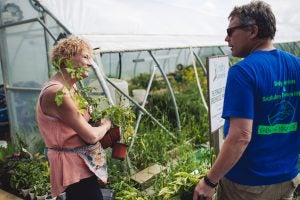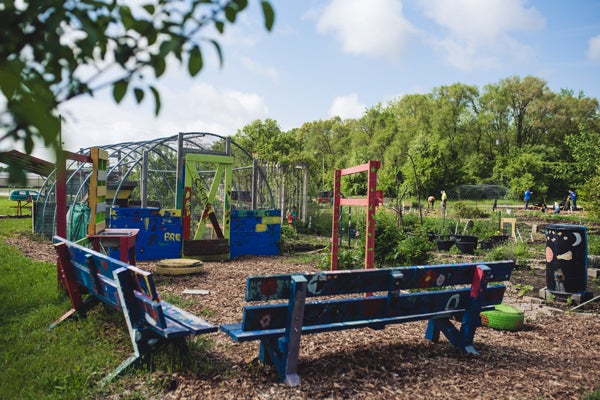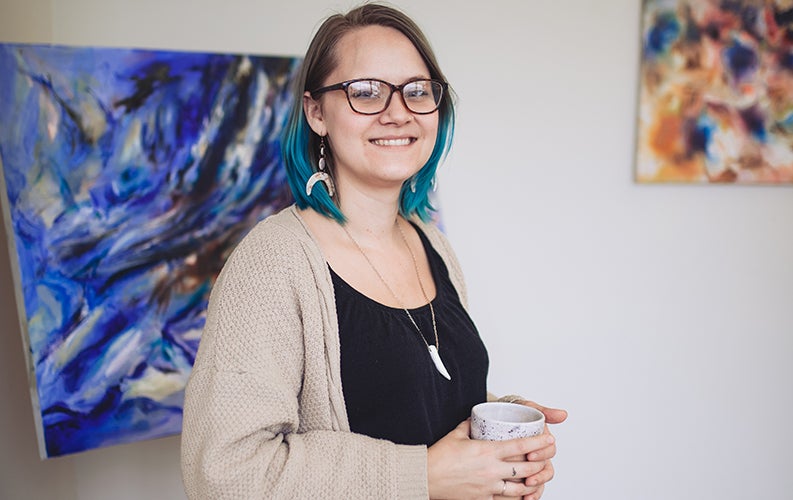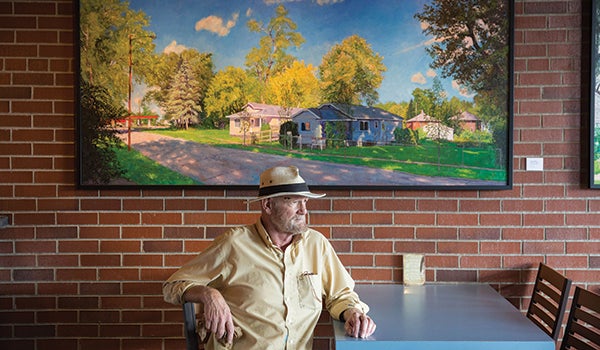Garden collaborative cultivates community
The Unity Garden’s welcome sign at its main urban farm is simple and subtle. It’s about shoulder height and outlined by a red, wooden border. The sign itself is black with cursive, yellow lettering.
The sign looks like it could be made by a high school student in a woodshop class — and it could have been because anyone is welcome to participate at Unity Gardens.
Nailed across the base of the sign is a purple plank that tells visitors almost everything they need to know when entering the Unity Garden grounds: “PICK FOR FREE.”
This three-word phrase is what separates Unity Gardens from more commonly known community gardens.
Even though Unity Garden, a nonprofit company, has been immersed in the South Bend community for more than a decade, people often assume it’s a community garden. It is not. Community gardens, which are popular in urban areas through the United States, are where people go to a neighborhood garden and grow food on their own reserved plot of soil. This is not the model at any of Unity Gardens’ more than 40 locations throughout the South Bend area.
 “Unity Gardens is where a group of people come together in the same environmental context and then they grow food for everyone,” said Sara Stewart, the founder and executive director of Unity Gardens. “So you don’t have to work in the Unity Gardens to enjoy the fresh produce, you don’t have to be poor, you don’t have to be anything. You don’t have to be from the neighborhood. Anyone is welcome here. Whether they’re just coming to harvest, whether they’re coming to enjoy, volunteer — we honor the fact that everyone wants to participate in this.”
“Unity Gardens is where a group of people come together in the same environmental context and then they grow food for everyone,” said Sara Stewart, the founder and executive director of Unity Gardens. “So you don’t have to work in the Unity Gardens to enjoy the fresh produce, you don’t have to be poor, you don’t have to be anything. You don’t have to be from the neighborhood. Anyone is welcome here. Whether they’re just coming to harvest, whether they’re coming to enjoy, volunteer — we honor the fact that everyone wants to participate in this.”
The garden’s layout supports this. Much of its border is without a fence or a wall. Its food and resources are open and available to the surrounding community and city. The garden itself is about 30 to 40 yards long and at least half as wide.
As early as May, there is food to be picked and sampled that comes straight from the ground. The first row of plants closest to the road is full of mustard greens, which can be trimmed and cooked similar to kale, or it can be eaten straight from the ground: farm to mouth.
“They’re spicy, so if you don’t like it, just spit it out,” Sara said. “We consider that food waste.”
Below a bench in the near the center of the gardens there are thriving spouts of asparagus that are crunchy and slightly juicy, especially when consumed raw.
“When it’s fresh like this, it’s so good,” she said.
All of the vegetables at Unity Gardens are grown naturally — not organically.
“Organic farmers typically do the same things as conventional ones in terms of plowing the land, putting organically certified pesticides and organic fertilizers on their fields and then harvesting them traditionally and all of that,” she said.
In Unity Gardens, gardeners avoid using any pesticides. All of the gardening is also done by hand, which allows them to manage the ecosystem underneath and maintain the soil health.
In the fall, cardboard is put all over the garden, creating a collage of ripped up and broken down boxes. This suppresses weeds, keeps water in the soil and attracts worms.
“Cardboard is like worm dessert,” she said. “They love it. In fact, later, after a heavy winter, you’ll just see pieces of tape because that’s all that’s left.”
In addition to offering an opportunity for anyone to harvest fresh, healthy food, Unity Gardens hosts classes to educate the community on how to grow and cook their own fruits and vegetables. These are often offered at little to no cost.
There are more than 150 Unity Gardens classes for both youth and adults that provide a variety of services, such as free summer kids camp, educational garden tours, volunteer groups and connecting the community with nature.
Other classes teach the community about raising egg-laying chickens and honey bees. In the center of Unity Gardens is a chicken coop with blue exterior walls and rounded fence over the top for a roof. To the back is a fenced off area containing an assortment of colored beehive boxes, from white to red to blue to brown. Some of the boxes have words written on them, while others show paintings of flowers.
The honey from the bees is renowned throughout the Midwest and is called Honey from the Hood. It has won a number of awards, including one from Michiana Beekeepers Association in 2013 that Sara did not even know they entered until the garden’s beekeeper, Tim Ives, told them they had already had won:
“He goes ‘you know that Honey from the Hood you’re selling? You won the best blind taste test for best tasting honey in the region.”
She responded.
“What? I didn’t even know I competed.”
Selling the honey is part of business and sustainability model that, in addition to donations and grants, helps to support Unity Gardens. The gardens also sell produce at the South Bend Farmers Market.
In the long run, Sara believes this model will help Unity Gardens be around for a long time. It was founded in 2008 — so long ago that its welcome sign is starting to fall apart and decay.
“We have a new one already,” she said. “It just has to be slacked and put up.”
She says 10 years is a long time for a nonprofit business that prides itself on allowing the community to take its products for free. But given the support Unity Gardens has received so far, it could still be providing people with healthy fruits and vegetables for years to come.





